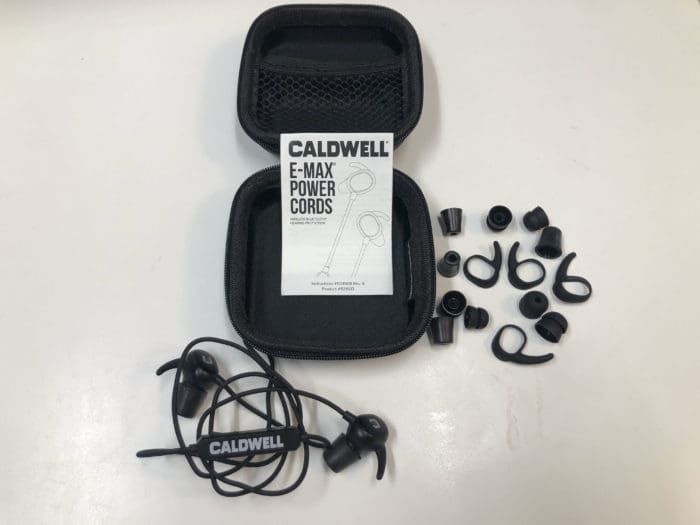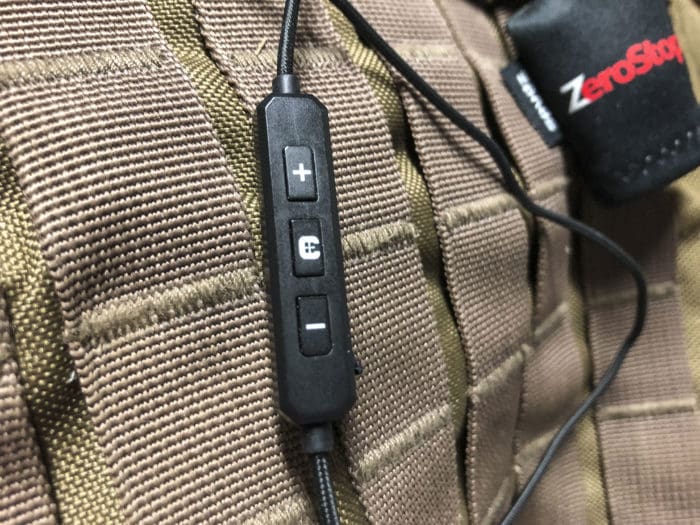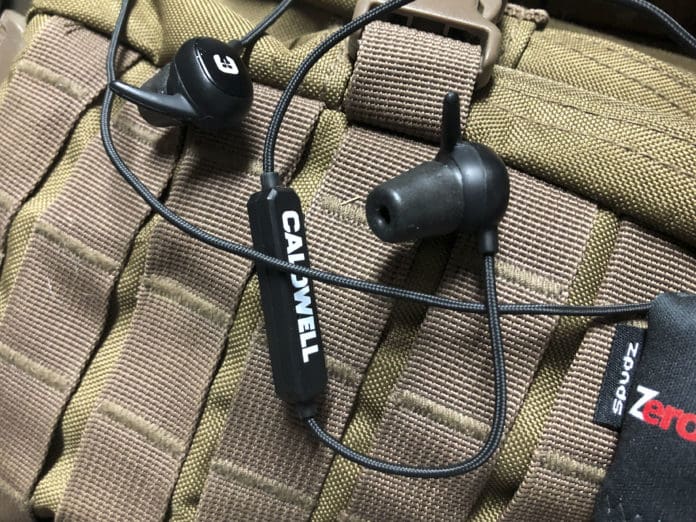I don’t know about you, but I use different hearing protection for different environments. And I usually default to the lightest, least obtrusive option that gets the job done based on where I’ll be shooting. I usually double up indoors with in-the-ear plugs and good over-the-ear muffs. But when I’m outdoors, I go with something lighter, cooler, and more flexible.

I’ve been using Caldwell’s Bluetooth enabled E-Max Power Cords for weeks now and I’m a fan. They come with a range of ear tips and silicone “wings” to fit your particular ear and situation. I use the larger foam plugs that are comfortable and provide the most protection. They’re great even when it’s hot out, and they stay securely in place.

Unlike some I’ve tried they comfortable and wearable for long periods. I used them for two solid days of training at Gunsite without them irritating my ears at all over hours and hours of constant use.
In addition to USB connection with your phone (I used them daily while walking the dogs or listening to podcasts) E-Max Power Cords also have adjustable ambient sound which works well for hearing an instructor or talking to others on the range. Pairing these with your phone is quick and easy.

The control buttons on the connecting cord are simple and intuitive. The central multi-function button lets you turn ambient sound on an off, pause and start music or a podcast your listening to, and answer phone calls. And while the Power Cords are rated at six hours on a full charge, I’ve had go almost eight hours, significantly better than other brands I’ve tried.
Two minor gripes. First, the multi-function button feels just like the volume up and down buttons. Caldwell would do well to give it a different texture to make it easier to distinguish by feel. Also, the microphone is located in the control strip. When ambient sound is turned on, if it rubs against your collar, you get a scratching sound that’s annoying. On the plus side, it does a good job filtering wind noise.
In short, I’m really happy with them. I’ve used other similar USB-enabled ear buds and the E-Max Power Cords are light, comfortable and their long battery life means they won’t crap out on you in the middle of a range session.
Specifications:
- 22 db NRR (noise reduction rating)
- Battery Life: 6 Hours per charge
- Micro USB rechargeable
- Bluetooth pairing with phones or other capable devices for music or phone calls
- Adjustable ambient sound amplification
- Multiple ear tips
- MSRP: $109.99 (street price about $75)





Is a 22 dB NRR really sufficient to prevent hearing damage for lengthy outdoor target practice?
I spent two long days around a lot of outdoor AR and GLOCK 19 fire. Not once was I bothered by the noise levels and I’m pretty protective of my hearing.
there is damage and then there is damage. Permanent damage can start at ~80 dB (some people a little lower and some a little higher). The maximum one time (that’s once in a lifetime) exposure level is ~140 dB (some people a little lower and some a little higher). 40 dB to 60 dB is that of a normal conversation.
what 22 dB NRR means is a 22 dB reduction in the dB level of the sound you hear. For example, if the noise you are exposed to is 100 dB, this hearing protection will reduce the dB level by 22 dB … so… 100 dB – 22 dB = ~ 78 dB that still reaches your ears.
Foam ear plugs on average have a maximum of 33 dB NRR.
A 16 inch barrel AR-15 firing standard M193 produces ~167 dB, depending on environmental conditions. 167 dB – 22 dB = ~145 dB that reaches your ear.
Noise level does not need to bother you to cause damage. The majority of hearing damage is not noticed until later in life when the damage has further degraded due to age. Hearing damage can be cumulative over time. The extent of the hearing damage depends on how long and how often you are exposed to to the noise.
“…damage has further degraded due to age.”
should have been
…damage has further degraded hearing due to age.
A Glock 19 suppressed noise level is ~134 to ~140 dB (on average, varies a little with the suppressor).
This hearing protection is 22 dB NRR.
134 dB – 22 dB = ~112 dB that reaches your ear from the suppressed Glock 19.
Basically; The reason a suppressor equipped gun sounds more quiet compared to an suppressed gun is because the design attenuates the impulse noise peaks to which human hearing is more sensitive. But, that ~134 to ~140 dB is still reaching your ears.
Its variable for the sound dB level that reaches your ear. A shooter firing an AR (or any rifle) is more likely to get more exposure than a person 3 – 6 feet away, same principal for a hand gun, simply because the shooter is closer to the weapon.
“…The reason a suppressor equipped gun sounds more quiet compared to an suppressed gun is because …”
should have been
The reason a suppressor equipped gun sounds more quiet compared to an un-suppressed gun is because …
“Basically; The reason a suppressor equipped gun sounds more quiet compared to an suppressed gun is because the design attenuates the impulse noise peaks to which human hearing is more sensitive.”
expanding a little, basically:
When the hot gases from firing enter the suppressor chambers and baffles the gases are slowed down which results in them cooling some which causes energy to be expended. The more the gases cool the more energy is expended, the more energy expended the more limited the pressure. Sound is energy in the form of a gas pressure (usually oxygen in open air) that vibrates at a frequency. As the gases are cooled the pressure is limited more in the chambers and baffles and in that pressure is also the sound energy. Because this pressure is being limited it has the effect of attenuating the peak impulse noise thus it sounds like the suppressed gun is quieter than an un-supressed gun. Thus the suppressor design attenuates the impulse noise peaks to which human hearing is more sensitive.
22 dB NRR isn’t bad, but its not really great either.
The higher the NRR the better, ok this is kinda an obvious thing.
But in terms of sound the secret is that dB reduction effectiveness increases by 50% reduction of the previous value for every 6 dB increase of NRR. Let me put that another way for reference context … if you gave me 6 dB of your paycheck you would be giving me half (50%) of your paycheck.
So 22 db NRR isn’t bad, but its not really great either because you can do better.
So some math to explain, assume where:
noise source = + 100 dB
hearing protection A = – 22 dB NRR
hearing protection B = – 28 dB NRR (a 6 dB increase in NRR)
thus:
Hearing protection effectiveness A = (+ 100 dB) – 22 db = + 78 dB
(because 6 dB is 50% – 28 dB is 6 dB great than 22 dB, therefore…)
Hearing protection effectiveness B = 78 dB / 2 = 39 dB reaching your ear.
the Titan Tactical 29NRR Reusable Shooting Ear Plugs are rated 29 dB NRR – $13.00 to $14.00
the Decibullz Custom Molded Earplugs are rated at 31 dB NRR – around $26.00
“A Glock 19 suppressed noise level is ~134 to ~140 dB (on average, varies a little with the suppressor).”
average = of peak sound pressure level. When you see a manufacturers suppressor ratings as some dB rating in their specs what you are seeing is either Peak sound pressure level measurement or Maximum Sound Level measurement. Both are mixed and matched among suppressor manufacturers, so some care in shopping is needed to get the correct suppressor as all suppressors of the same suppression dB level may not be equal.
In a peak sound pressure level measurement there is no time-constant applied and the signal has not passed through RMS (‘root mean square’) processing in the measuring device. This is the true peak of the sound pressure wave. In its true form of representation it is expressed as a C-weighted peak measurement of “LCpeak” and written as “dB(C)”. The LCpeak measurement is used for noise measurement where loud bangs (impulse noise) are present (yes, like in weapons fire). This measurement is not used for environmental noise measurement and is useless when any wind, even a slight breeze is present, or other environmental noise is present. A very slight breeze or other environmental noise can very easily cause the LCPeak readings to be incorrect. The end result is represented in “dB”.
Tip: One well known suppressor manufacturer does the measurements on a range outside using peak sound pressure level measurement. If you see a person (or manufacturer) using this measure method outside to rate a suppressor, all or most of their separate readings are most likely wrong which is why manufacturers cheat a little and need to take an average over multiple firings so the suppression level seems “better” and that’s the reading they give. They usually throw in a little ‘smoke n mirrors’ advertising/marketing to make it seem to be the best thing since sliced bread.
Maximum Sound Level is the maximum value reached by the sound pressure. It is the highest value measured by the sound level meter over a given period of time. This measurement is based on the time-weighted sound level in dB, using either a fast or slow time constant. The end result is represented in “dB”
Both the ‘Maximum Sound Level’ and “peak sound pressure level” measurements are usually represented to the public as just “dB’.
The peak sound pressure level will be 3 dB above the Maximum Sound Level. This is significant because in terms of “sound pressure level” (not the NRR level I wrote about above) 3dB represents 50% meaning in this case the “peak sound pressure level” dB represents 50% greater sound pressure level than the Maximum Sound Level for the same dB rating under each measurement.
For example, two suppressors from different manufacturers are rated to have, lets say for the sake of math, -10dB sound suppression…
suppressor A rating was measured via peak sound pressure level measurement.
suppressor B rating was measured via Maximum Sound Level measurement.
Even though both have the same suppression level rating in dB suppressor A is actually suppressing more sound than suppressor B because it is suppressing 50% more of the peak impulse noise of the weapon firing sound.
This is why you sometimes see people with suppressors from different manufacturers saying that although the ratings are ~= one is much “louder” than the other. The reason is two different measurement methods were used.
“Even though both have the same suppression level rating in dB suppressor A is actually suppressing more sound than suppressor B because it is suppressing 50% more of the peak impulse noise of the weapon firing sound. ”
assuming that each measurement for suppressor A and suppressor B are correct.
thanks for sharing
very nice
So anyway I traded an 30carbine that I paid $75 for , for a Cararcano.
Told the guy, ” Sure it’ll kill a deer.”
About a month later the guy says I’m full of shit, “Like what?” , – ” I shot a deer with it last week and it run off”
Where’d you shoot it?
” Dead square front on in the chest”
Welp shoulda waited for a head shot.
“Ehh f7ck you, I got rid of it. ”
Who to?
“Pawn shop ”
Went to pawn shop and the guy wanted $275.
I said 275, the SOB wont even kill a deer, and that’s the same gunm I bought for $75.
I still dont see how Oswald pulled off what he did, that Carcano was a piece of shit, I tried(in re-enactment)and I’m no slouch, maybe he had a smoother gunm? Plus bullets was way high, Norma only I could find, but itd kill a deer a whole lot better then a 30carbine.
Man did that guy I traded with get pissed when he seen a deer hanging on my skinning tree.
Yee Yee
You had me worried a day or so back when you said you were bailing on TTAG.
You’re probably the most sane one in TTAG. 🙂
Oh, there’s Kyle Rittenhouse trial news at the ‘Zero Hedge’ :
“FBI Sat On Bombshell Footage From Kyle Rittenhouse Shooting”
“During the course of the evening, protesters became increasingly violent against Rittenhouse and the group he was with – eventually chasing the teen down the street when protester Joseph Rosenbaum was shot dead in the parking lot of a used car dealership. Shortly thereafter, Rittenhouse could be seen defending himself on the ground from multiple attackers – when he fatally wounded another, and shot the bicep of protester Gaige Grosskreutz who had drawn a pistol and was in the process of aiming it at the teen.”
And there’s a *nice* picture of the remains of fascist Gaige’s bicep in that article…
The only thing I can see is 17 with a gunm in a different state.
Kyle is quite a man for 17, just wondering how many dead would be left on the street had it been a police officer being chased, clubbed and assaulted?
Nice article on the Kyle Rittenhouse trial, with bloody bicep pic as a *bonus* :
https://www.zerohedge.com/political/fbi-sat-bombshell-footage-kyle-rittenhouse-shooting
Caldwell claims NRR=22dB (without describing which tips achieved that rating) and they say “for maximum hearing protection, use the memory foam ear tips.”
A competitor claims NRR=19dB with silicone tips and NRR=29dB with foam tips. But I found even their provided foam tips didn’t seem to give that level of protection. So I replaced the original foam tips with Comply™ foam Canal Tips and now I’m completely satisfied with the protection.
You might try Canal Tips with these Caldwell E-Max® Power Cords too.
essay代写
Actually, they do suck…. Or are awesome since I’ve found they don’t handle some female voices very well which is great if you don’t want to hear them.
Very exciting article! I thank the author for such a detailed analysis of the market and topics. This material is very close to me, since I myself am a beginner in the technical field. I am now at a point in my career where I need to soak up a lot of professional information.
Nice blog 🙂
Comments are closed.